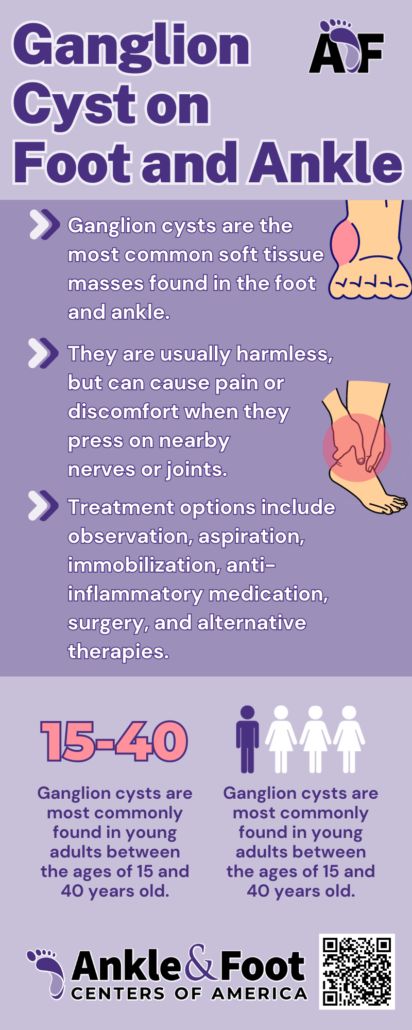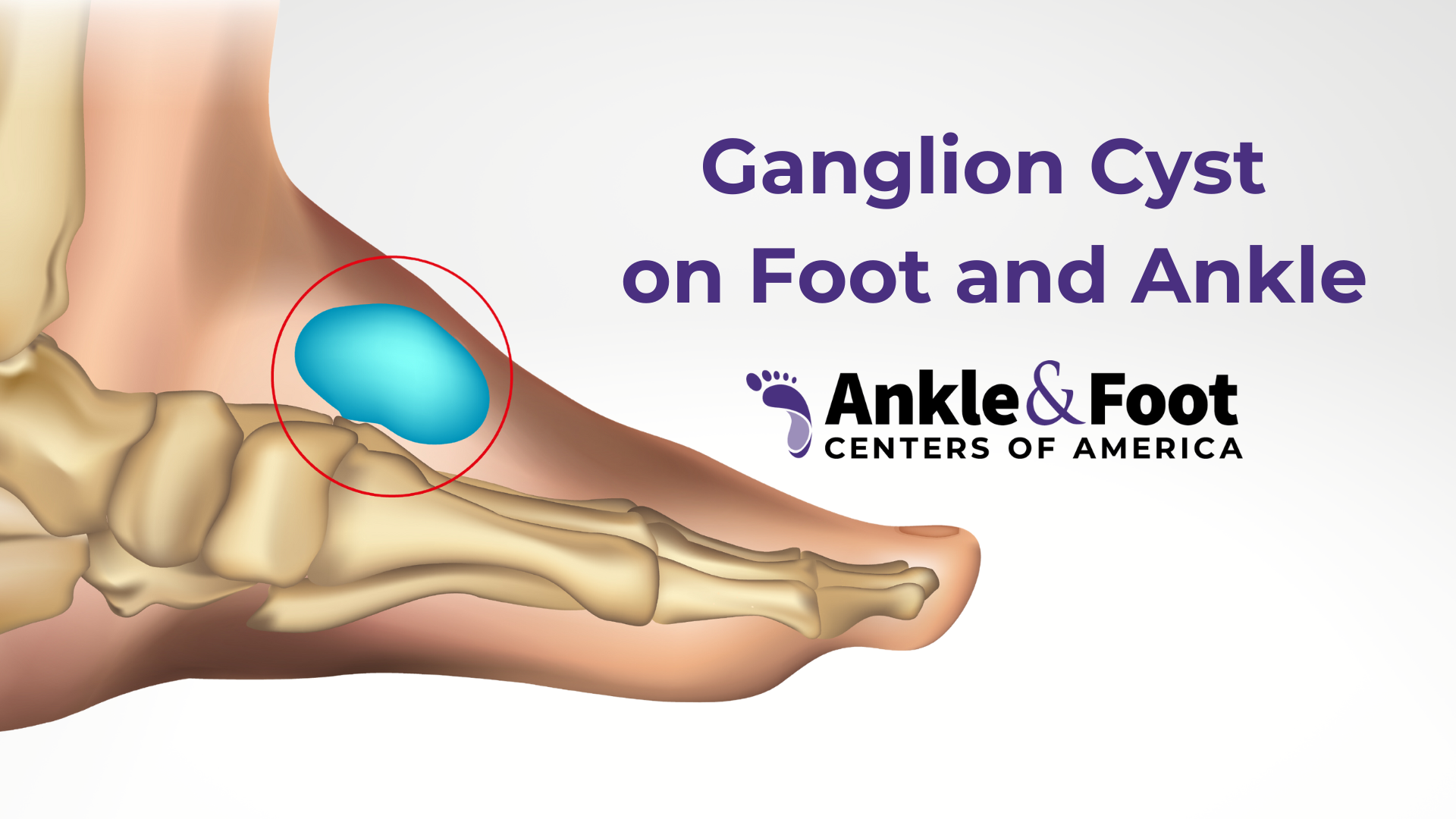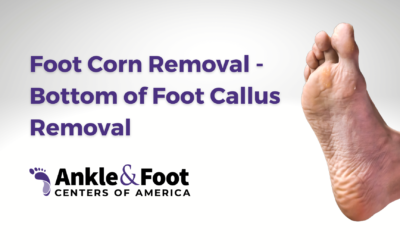Are you experiencing an unusual and uncomfortable lump on your foot or ankle? Don’t worry! We’ve got you covered with this comprehensive guide on ganglion foot cyst in Nashville. Learn more about their symptoms, causes, and available treatment options, and discover how to choose the right foot and ankle specialist for your needs. Let’s dive in and explore the exciting world of ganglion foot cysts!
Key Takeaways
- Unlock the mysteries of ganglion foot cysts and explore treatment options!
- Get excited to learn about symptoms, diagnosis & non/surgical treatments for ganglion foot cysts!
- Choose a Foot and Ankle Specialist in Nashville with expertise & experience for comprehensive care.
Understanding Ganglion Foot Cysts
 An analysis of ganglion foot cysts reveals they are fluid-filled pockets which have their origins in tendon sheaths or joint capsules and often cause pain. Such soft tissue masses may take the form of small bumps to large lumps, similar in size to a golf ball, near joints or tendons on either the ankle or foot region. So what leads to these perplexing formations and could anything provoke them? In this article we delve into the mysteries surrounding ganglion feet cysts!
An analysis of ganglion foot cysts reveals they are fluid-filled pockets which have their origins in tendon sheaths or joint capsules and often cause pain. Such soft tissue masses may take the form of small bumps to large lumps, similar in size to a golf ball, near joints or tendons on either the ankle or foot region. So what leads to these perplexing formations and could anything provoke them? In this article we delve into the mysteries surrounding ganglion feet cysts!
Fluid-filled sacs
Ganglion cysts are small pouches of jelly-like fluid that arise from a tendon sheath or joint capsule. Their size can range anywhere from the diameter of a pencil eraser up to quarter and they may come as one lump or multiple lumps. This gelatinous material is made by either the tissue in between tendons or at joints, hence why ganglion cysts often alter depending on how much movement there is around those areas. This could even be related to an injury present within the structure like tendons. It’s quite astonishing that such insignificant looking formations might induce considerable discomfort!
Common locations
Ganglion cysts are typically seen on the foot and ankle, usually taking shape as a soft lump. The top of the feet is an area particularly prone to developing these peculiar types of cysts. They can also occur along tendons or joints too. What leads to this kind of growth remains unknown, but may be linked with trauma or pressure placed on them in some cases. Whatever their cause might be, ganglion cyst diagnosis requires proper care by medical professionals for effective treatment results.
Potential Causes of Ganglion Foot Cysts
The formation of ganglion foot cysts has an underlying cause that is yet to be fully understood. It is thought that injuries including joint and tendon damage or even a single traumatic event could possibly contribute. Enduring minor traumas over time may also have some impact on the development of these cysts.
Investigation into how one major incident as well as recurring microtrauma can influence their presence should be conducted in order to gain better comprehension regarding this matter.
Single event trauma
The cause of ganglion foot cysts may be attributed to a single traumatic event, such as sports-related trauma. Despite the uncertainty surrounding its origin, it is believed that joint tissue damage resulting from an injury can result in this type of formation. To help prevent these growths and protect our feet healthfully, we must take precautions like wearing shoes at all times. By doing so we reduce the chance for any possible traumas which might bring about the development of said cysts.
Repetitive microtrauma
Ganglion foot cysts may form due to repetitive microtrauma, when the musculoskeletal tissue is frequently exposed to low-level forces. Sports and activities with frequent hand and wrist movements such as tennis or gymnastics have been linked with increased risk of these types of damage resulting in a one-way valve for fluid leakage which forms the cyst. To identify symptoms associated with ganglion foot cysts, look out for swelling around joints that contain synovial fluid. This can cause visible bumps on either side of the joint line accompanied by tenderness or numbness near them. Patients may experience sensations like “pins & needles” from nerve impingement caused by pressure from build up fluids leaking into other surrounding tissues.
 Recognizing Symptoms of Ganglion Foot Cysts
Recognizing Symptoms of Ganglion Foot Cysts
When trying to diagnose a ganglion cyst, it is important to be aware of the common symptoms associated with this condition. These can include a lump that appears on the foot and may grow larger when joints move. Pain ranging from dull ache up to severe throbbing sensation as well as tingling or burning sensations in some cases. People are likely to develop more than one ganglion cyst which could Exacerbate their symptoms such as swelling and joint discomfort. In order for proper treatment recommendation for each case, it is essential that an accurate diagnosis by healthcare professionals takes place so necessary action can commence right away if needed.
Noticeable lump
A very apparent and distinct lump on the foot is usually one of the tell-tale signs that a person has acquired ganglion cysts. This bump may appear in various sizes, from being no larger than a pea to as big as an actual golf ball. It will always be noticeable when wearing footwear or taking steps. It can also change its shape slightly over time while staying symmetric overall.
It is important for anyone who notices such bumps to promptly seek professional advice since confirming this kind of diagnosis requires medical expertise.
Pain and discomfort
The presence of a cyst in the foot or ankle can result in considerable pain and distress, ranging from mild aches to more severe throbbing. There may also be difficulty putting on shoes as friction between the shoe and the lump increases discomfort. Early treatment is important for relieving these unpleasant symptoms associated with ganglion foot cysts. This includes paying attention to any tenderness around tendons or nerves that could indicate pressure being exerted by one of these growths.
It’s essential not only to identify any painful lumps quickly but to receive professional medical advice about how best they should be handled: such steps are necessary if alleviation of both dull aches and severely sore sensations stemming from untreated cases is desired!
Tingling or burning sensation
If a tingling or burning sensation is experienced in the foot, it could indicate that there are ganglion cysts present. The degree of discomfort associated with these cysts varies based on their size and position. Medical assessment must be sought to determine if this is causing such sensations and how they should be treated accordingly.
It’s essential to get help from an expert for accurate diagnosis if one finds themselves struggling against painful tingles or burns as those can result from a small glandular sac which lays near the nerve endings around joints throughout our body – known as Ganglion Cyst!
Diagnosing a Ganglion Foot Cyst
Having noticed the indications of a ganglion foot cyst, it is essential to receive an accurate diagnosis. Medical practitioners typically rely on physical examination and imaging procedures such as x-ray scans, ultrasound examinations or MRI scans for identifying this type of cyst. In order to fully evaluate these results in greater detail, we will now review each stage of the diagnostic process more thoroughly.
Physical examination
A physical examination is a reliable method for identifying ganglion foot cysts, as it enables healthcare providers to measure the size and position of any such lumps or masses. To do this, they visually observe the affected area before applying pressure onto the lump in question to check if there’s tenderness present. Transillumination – where light is shone through said cyst – can assist with diagnosis too.
Imaging tests
Imaging tests like x-rays, ultrasound and MRI are utilized alongside a physical examination to correctly identify ganglion foot cysts. X-ray imaging is employed to discard other ailments along with uncovering bone issues while an ultrasound or MRI can give Detail into the presence of these cysts allowing for a precise prognosis as well as an optimal treatment strategy. These diagnostic tools offer up detailed imagery that provides insight into both the affected area and the affected area. To its surrounding structure enabling better informed medical decisions regarding one’s condition.
Non-Surgical Treatment Options
A ganglion foot cyst can be treated without surgery. The available options include aspiration and steroid injection, as well as changes to footwear for relief of pain caused by the cyst. We will now take a closer look at these non-invasive treatment methods in more detail. Aspiration is typically done with local anaesthesia to draw fluid from the cyst, while steroids are injected directly into it and may help reduce inflammation that could cause discomfort or aggravating existing pain due to its presence. Modified shoes might provide extra support around an area affected by the growth – protecting against any damage.
Aspiration and steroid injection
Numbing the area around a cyst, draining away its fluid with aspiration and injecting steroid medication are common non-surgical treatments used to combat ganglion foot cysts. This method can be effective in shrinking the size of these lumps and providing short term relief. Recurrence rates may range from 43.3% up to 73.2%.
Footwear modifications
Decreasing the pain associated with ganglion foot cysts can be achieved by using footwear modifications. For example, wearing shoes that provide ample support and which have a wide and square toe box may help reduce any pressure on the cyst. Inserting pads into your shoe or custom orthotic inserts to give extra cushioning will also go some way in alleviating discomfort caused by these growths. Lastly, draining is another technique that could lead to relief for those suffering from this condition.
Surgical Treatment Options
 Surgical treatment options for ganglion foot cysts can be an option when non-surgical treatments fail to provide relief. Surgery indications and techniques are available, which involve removing the cyst while also preventing recurrence. We will now explore this surgical approach in more depth. Different methods exist that focus on taking out these types of cysts as well as making sure they do not reappear again afterwards.
Surgical treatment options for ganglion foot cysts can be an option when non-surgical treatments fail to provide relief. Surgery indications and techniques are available, which involve removing the cyst while also preventing recurrence. We will now explore this surgical approach in more depth. Different methods exist that focus on taking out these types of cysts as well as making sure they do not reappear again afterwards.
Indications for surgery
For ganglion foot cysts, it may be necessary to have surgery if other treatments are not effective or appropriate. Surgical treatment should also be considered in cases of severe symptoms and when the cyst is impacting nerves or blood vessels. Consulting with a healthcare provider is essential for determining what option will best address your condition involving these types of growths. It’s important that all relevant information related to the cyst and its associated effects on health remains intact as part of this decision-making process.
Surgical techniques
Ganglion cysts located on the foot can be removed through several surgical techniques. Resection involves making a cut to remove both the cyst and its attaching root, while excision surgery similarly requires an incision to eliminate them as well. To reduce scarring post-surgery, minimally invasive approaches such as endoscopic stalk-only resection or arthroscopy are also options in some cases.
It is important to understand that even with successful treatment of ganglion foot cysts, there is still a chance they could recur after being operated upon.
Choosing a Foot and Ankle Specialist in Nashville
When looking for a foot and ankle specialist to treat your ganglion cyst in Nashville, it is important that you choose the most qualified medical professional. Review their speciality, proficiency and comprehensive care options available before selecting the right one who can ensure successful results. Here are some tips when making this decision: Make sure they have experience treating these types of issues, inquire about what kinds of treatments will be offered along with any associated risks, and ask questions to determine whether or not they specialize in exactly what type of treatment best suits your specific needs as well as how quickly expected outcomes may be achieved.
Expertise and experience
Verifying the expertise and experience of an ankle surgeon in treating ganglion foot cysts is critical. Do this by studying credentials, reading patient reviews, asking your primary care doctor for advice, and looking into their affiliations or memberships. Make sure they have substantial education regarding feet/ankles surgery, board certification either in podiatry medicine or orthopedic medical field, plus additional special training to manage conditions concerning those areas too. This will ensure a successful treatment!
Comprehensive care
When looking for a foot and ankle specialist in Nashville to treat ganglion cysts, it is important to select one that offers comprehensive care. This type of treatment comprises an array of approaches – from surgical intervention down through non-invasive procedures. Personalized plans based on the patient’s needs. Plus post-treatment follow up as well as rehabilitation programs designed to ensure maximum recuperation together with long term effectiveness. By choosing a doctor who provides all these elements, you can be certain your feet are in safe hands!
Summary
It is vital to recognize the signs and symptoms associated with ganglion foot cysts. These fluid-filled sacs located on either a person’s ankle or feet can cause distress in terms of pain and discomfort. Despite not knowing their exact cause just yet, single event trauma as well as repeated microtrauma are assumed by many experts to have an influence upon them forming. Aspiration with steroid injection plus adjustments made to footwear may be adequate treatment options for relieving aches but if they prove unsuccessful then surgical intervention might need taking into account instead which is why enlisting a Nashville based specialist who possesses knowledge, practice and wholehearted care could make sure you get the best possible outcomes achievable! Let’s wish ourselves happy healthy feet indeed!
Frequently Asked Questions
What doctor do I see for ganglion cyst on foot?
If you have spotted a bump on your foot or ankle, it is possible that it could be an indication of ganglion cysts. It would be highly beneficial to get in touch with either a podiatrist or foot and ankle surgeon for diagnosis as well as treatment recommendations. These professionals possess the competencies and knowledge required to take care of any type of ganglion cyst at the level of feet and ankles.
Can a dermatologist remove a ganglion cyst on the foot?
Dermatologists are able to get rid of a ganglion cyst on the foot by utilizing treatments such as aspiration with a sterile needle, cortisone injections and cryotherapy in order to reduce any swelling associated with it.
What is the best treatment for a ganglion cyst on foot?
An orthopedic surgeon is the most recommended for treatment of a ganglion cyst on the foot, usually removed surgically. Conservative options like aspiration injection with steroids, padding and changing footwear may be prescribed but are not as successful in resolving it.
Can an orthopedic doctor remove a ganglion cyst?
If the pain is significant, an orthopedic specialist who specializes in hand and upper limb conditions can help remove your ganglion cyst. They have the necessary knowledge to decide on a suitable treatment plan for you!
What is a ganglion foot cyst?
A ganglion cyst in the foot is an inflamed, painful collection of fluid stemming from either a tendon sheath or joint capsule located on the ankle or foot. It can be irritating and uncomfortable due to its nature as a sack filled with liquid around a nearby tendon.




